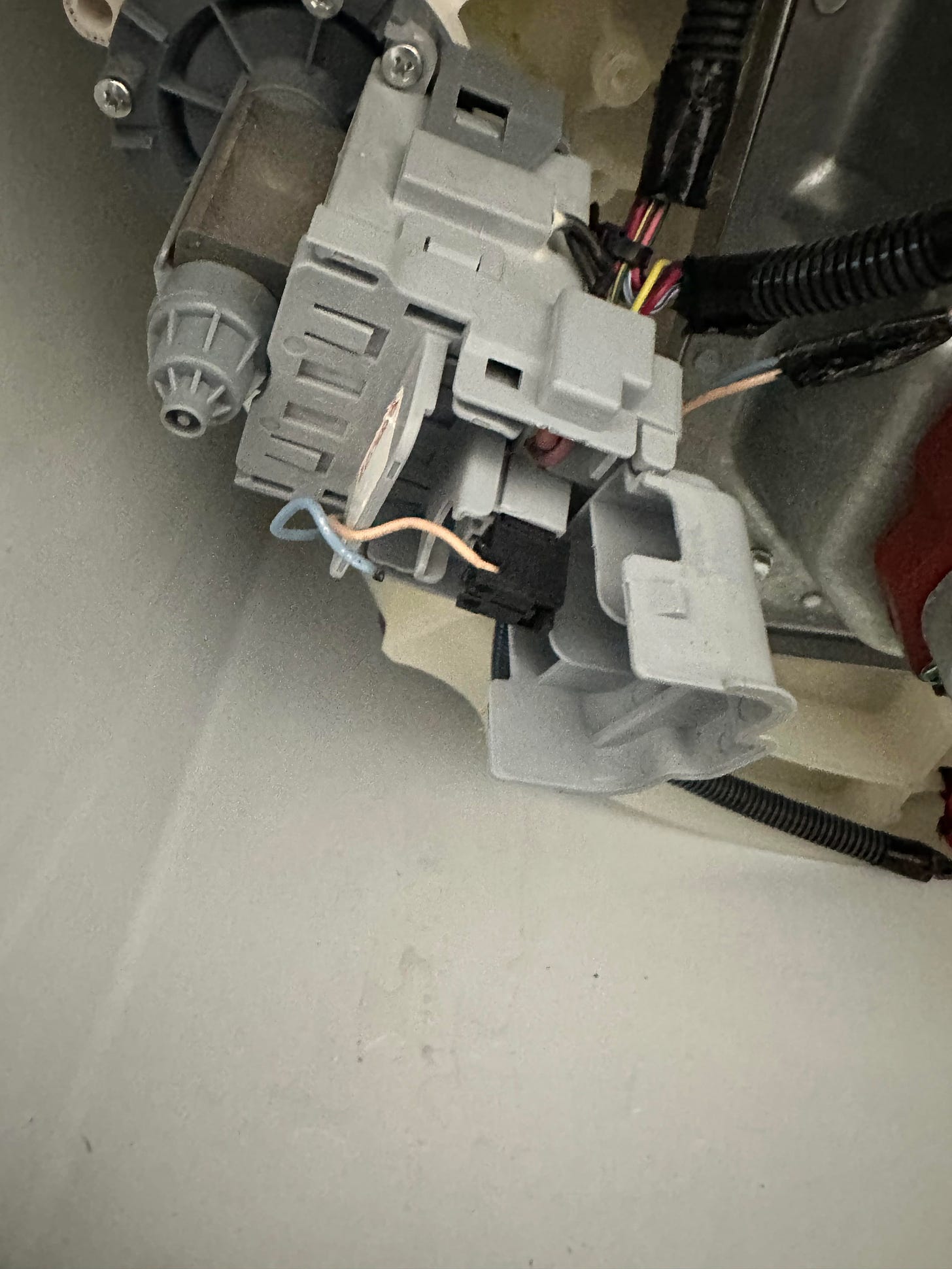“The washing machine won’t work”, she said, and my stomach sank.
For context, the annoyance of a broken appliance didn’t conjure up a feeling of dread all on its own. No, the proceeding transmission explosion, plumbing debacle, and absurdly high water bill that destroyed a well-supplied emergency fund set the stage for the emotion. The threat of another $1,000+ expense presented another problem I didn’t want to solve.
With a baby in the house that regularly dirties multiple cloth diapers daily, a broken washing machine presents an entirely new dimension of urgency. While I can, and have, go on wearing the same clothes day in and day out, a poop-filled diaper needs the rejuvenation of a modern washing machine. Given the cost of disposable diapers (and everything else, for that matter), the washing machine even takes on a cost-saving dimension that can’t be ignored.
So out came the toolbox and multimeter, and I scoured the internet for exploded parts lists, wiring diagrams, and system schematics. Not to my surprise, but Maytag never seemed to put that level of engineering out to the public. With a pooping baby to keep pace with, I didn’t have the time to continue my quest for the needed resources to troubleshoot the appliance. The only way forward lay in “wild west” troubleshooting. Just my brain and a multimeter against a Maytag enigma that refused to work.
I squared up on the labyrinth of cheap sheet metal, components made by communists, and crisscrossing, mislabeled wires. I squinted my eyes as my gripped yellow fluke meter hung by my side. The “sensing” light flashed, indicating some sort of sensor error. The washing machine might as well spit as we drew and commenced battle.
I sauntered over to the machine and raised the lid. Water stood halfway up the tub and hadn’t drained. Was that the result of a bad drain pump? Or had the control board never told the pump to engage? What debauchery lay in this dusty old machine that leaked into an otherwise peaceful Thursday afternoon?
Self Diagnostics Suck (Especially Yours)
When I engaged the washer’s self-diagnostic feature, lights flashed in a binary sequence. First came a 1. Then a 2. Next, a 3…..the washer continued to count all the way to 12. Instead of flashing a code, it only produced meaningless knowledge that showed it knew how to count. Fascinating.
Self-diagnostics suck. Think about it: you ask something broken to tell you how it’s broken. If it knew that, it likely would never have broken in the first place. I’ve seen this dynamic play out with large commercial jets and even my vehicles. Self-diagnostics often tell you information that doesn’t help and only confuses things further.
As a chaplain, I’ve seen this with people as well. Most of the time, people sit in front of me and spill their guts about situations that have gone from bad to worse due to their own “self-diagnostics.” Their haphazard approach to life gets them in some sort of fix, and then, to get out of it, they employ the same broken thought process. The result is a bad situation, only getting worse.
So how do you fix it? Call a repairman, preferably someone who knows how to fix things. However, sometimes, a friend who can look at the situation from the outside and see what you can’t goes a long way. If you want to know the truth, that is 90% of what I do as a chaplain. I spend most of my time listening and asking hard questions people don’t want to ask themselves.
Don’t Jump to Conclusions
When Cait told me the washer quit, I started doing math and thinking about shuffling money around to pay for a new washer. Then, as I tore into it, all I could think about was how much a new control board would cost. I just knew the most expensive part had to be the issue. Each thought could have been employed to solve the problem, but instead, was uselessly spent on worry.
Yet, as I played around with it, tricked sensors, and increased my understanding of the problem, I realized that the control board worked perfectly. My previous anxiety about replacing an expensive appliance or a critical part of it was totally unfounded. I had jumped to conclusions and anticipated the worst possible scenario. The result? Unwarranted anxiety and frustration.
I’ve seen this with people as well. When something doesn’t go exactly as planned, they anticipate the world to come crashing down. They often believe it to the point it becomes a self-fulfilling prophecy. I can’t tell you how close I was to buying a new washer or a new control board. If I had given in to those emotional, non-analytical impulses, then I would have brought my own worries into reality. People often cause problems in the workplace, marriage, and relationships because they worry about one thing to the point where it becomes a reality.
Don’t do that.
The Power of The Simple
Once I had laid to rest my fears of a faulty control board, I sat back and looked at what the washer was doing. I drained it manually and started a load. It ran perfectly until it came time for the “spin and drain” part of the cycle. So I drained it again and then started the process over. This time, the same thing happened.
“Ah, this is a drain pump issue,” I said to myself. Now, I had something solid to go on. Now, all I needed to do was flip the washer over and troubleshoot a component instead of an entire system. I could ensure the pump was getting power, that it wasn’t seized, or that one of Murphy’s tiny socks hadn’t clogged it up. Each situation was easily remedied; the worst I could be out would be a $100 pump.
As I opened the cover to the pump, one of the power wires fell out. It had burned right at the connector, indicating it had been slowly breaking since it left the factory. Likely, the vibrations of the washer had slowly broken the strands of the aluminum wire until the last few burned under the increasing heat of the amperage. Re-terminating the wire would solve it with no cost and even provide a little troubleshooting fun for me.
Life is often like this. We think it’s something monumental, but really, a simple fix will get rid of the problem entirely. I remember Russel Ackoff telling a story about how a bellhop suggested that they install mirrors by the elevators in a big, high-rise building. The complaints of the people about slow elevators went away instantly. Why? The people could look at themselves in the mirror and not at each other awkwardly while waiting on the elevator. Oftentimes, the solution lies in the simple, not the complex.
Hone The Edge.



















This was really fun to read, and boy can I relate to the struggle.